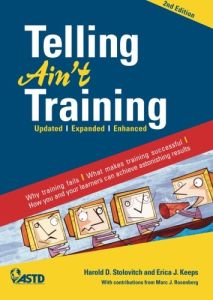Join getAbstract to access the summary!

Join getAbstract to access the summary!
Harold D. Stolovitch and Erica J. Keeps
Telling Ain't Training
Why Training Fails; What Makes Training Successful; How You and Your Learners Can Achieve Astonishing Results
ASTD Publications, 2003
What's inside?
Training does not just convey data; it transforms people by giving them skills and knowledge that affect their lives.
Recommendation
This excellent book by Harold D. Stolovitch and Erica J. Keeps - researchers and consultants in workplace learning and performance - emphasizes making training fun and interactive. While their basic learning principles will be familiar to those in the field, they enliven their book with examples, exercises and research. The authors distinguish among training, instruction and education. They note the differences among various types of knowledge. Then, they explain the major factors that motivate people to learn and show how to apply these principles in hands-on teaching situations. Charts, illustrations, quizzes, and short chapter summaries enrich the book. getAbstract.com believes that even professionals already familiar with the field will enjoy this refreshing and lively look at how to help people learn. And if you are hiring trainers, this is what they should know.
Summary
About the Authors
Instructional systems technology expert Harold D. Stolovitch, Ph.D., studied learning and performance results, created workplace instructional materials and wrote almost 200 articles, research reports, book chapters and books. Erica J. Keeps worked in learning, performance and training management with major corporations for 30 years. She published extensively on workplace learning and developed instructional materials and performance management systems.














Comment on this summary